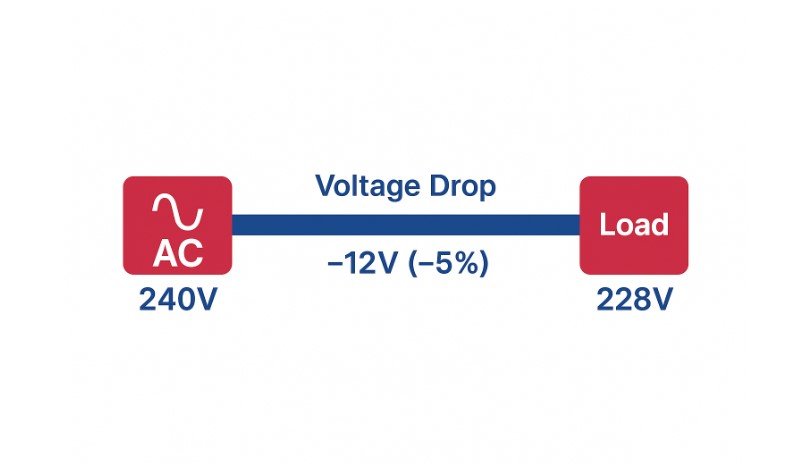The AS NZS 3000 Wiring Rules, formally titled AS/NZS 3000:2018 Electrical Installations, define the minimum requirements for low-voltage electrical systems. These rules apply to the safe design, construction, and verification of installations across Australia and New Zealand.
A fundamental aspect of compliant electrical design under this standard is controlling and calculating voltage drop. To guide you on applying this standard to this specific electrical issue, our article will guide you through its prescribed limits, accepted calculation methodologies, and best practices for ensuring compliance during the design and installation process.
Purpose and Scope
This wiring standard is intended to provide a uniform and comprehensive approach to electrical safety and system reliability. Its objectives include:
- Minimising the risk of electric shock, fire, and injury
- Promoting consistent practices across jurisdictions
- Supporting efficient system design and performance
In Australia, the standard is incorporated into state and territory regulations, making it a legally enforceable document. In New Zealand, it is recognised under the Electricity (Safety) Regulations 2010, and while not always mandatory, it is widely adopted as a means of demonstrating compliance with the law and to effectively calculate voltage drop with ease.
As a whole, this standard is used extensively by electrical engineers, consultants, designers, and contractors working on residential, commercial, and industrial installations.
Voltage Drop Requirements
Here are the voltage drop limits specified in the wiring standard, highlighting compliance requirements for efficient and safe electrical installations.
Voltage Drop Limits
Clause 3.6 of AS NZS 3000 outlines the voltage drop requirements for electrical installations. It states that the voltage drop from the point of supply to any equipment must not exceed levels that would impair its proper functioning.
That said, the standard provides a general guideline for a maximum voltage drop of 5% from the origin of the installation to the terminals of any electrical appliance. This recommendation is based on maintaining energy efficiency and equipment reliability.
Application Across Circuit Types
Voltage drop considerations apply to all parts of an electrical installation, including the mains supply cables, submains and distribution circuits and final subcircuits supplying individual loads.
In this case, designers must ensure that the total voltage drop across each segment, when summed, does not exceed the standard’s recommended limits. Achieving this may require larger conductor sizes or alternate routing methods for long cable runs or high-load installations.
Methods to Calculate Voltage Drop
You can use multiple methods to effectively calculate a voltage drop in electrical circuits, each varying in complexity and application suitability. These methods are Ohm’s Law, Voltage Drop Formula and Power Factor.
Ohm’s Law Method
This approach applies the fundamental formula:
Voltage Drop = I · R
where I is the current in amperes, and R is the resistance in ohms. This method provides a basic estimation suitable for simple circuits.
Voltage Formula Method
A more detailed calculation uses the following formula:
Voltage Drop = 2 · I · L · R / 1000
where I is current (A), L is circuit length (m), and R is conductor resistance (Ω/m). This method is widely adopted for single-phase and three-phase systems, especially when conductor resistance values are obtained from AS/NZS 3008:2017. Designers must ensure the voltage drop remains within the allowable limits specified in AS/NZS 3000:2018.
Power Factor Method
The most accurate method incorporates the circuit’s power factor to account for both resistive and reactive components. This approach is particularly suitable for commercial and industrial applications with inductive loads. In fact, most companies like CableHero employ this method to provide precise voltage drop calculations following AS/NZS 3000:2018 and AS/NZS 3008:2017.
Using CableHero’s Voltage Drop Calculator
Tools like the Cablehero advanced calculator can simplify and streamline the calculation process and assist with fast and accurate assessments. This tool lets users input parameters such as load, distance, cable type, and installation conditions to automatically compute voltage drop and verify compliance with the wiring rule.
By integrating such tools into the design workflow, professionals can reduce the risk of oversights and ensure installations are both code-compliant and efficient.
Simplify your Calculations with CableHero!
Voltage drop compliance is a fundamental aspect of electrical system design under the wiring standard. By adhering to the standard’s recommended limits and using accurate calculation methods, professionals can ensure that installations operate safely and within legal requirements.
Tools such as the CableHero voltage drop calculator offer practical assistance. With a growing emphasis on energy efficiency and system reliability, applying the provisions of AS NZS 3000 correctly is not only a regulatory obligation but a sound engineering practice.
If you need support, information, or have a specific inquiry, feel free to contact us today. Our team is ready to help!
Frequently Asked Questions (FAQs)
If you want to know more about the wiring rules, check out this additional information:
What is the standard AS NZS 3000?
This standard outlines the rules for designing, building, and checking electrical installations, including choosing and installing the right equipment.
What is the insulation resistance test as NZS 3000?
In Australia, AS/NZS 3000:2007 requires insulation resistance testing with a 500V or 1000V tester. There must be at least 1 megaohm between live wires and earth, and 10,000 ohms for low voltage devices like stoves and water heaters.
